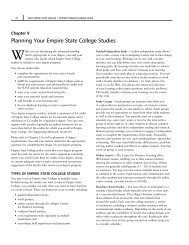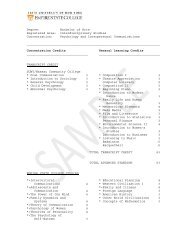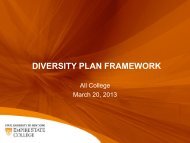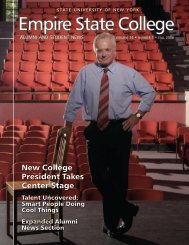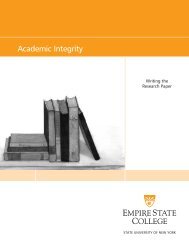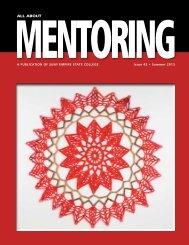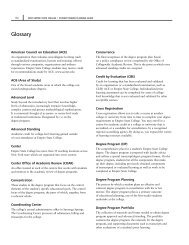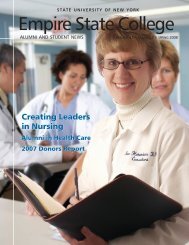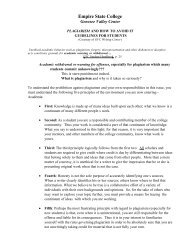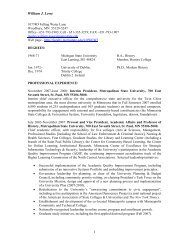Academic Plan 2011-2015 (PDF 524kB) - SUNY Empire State College
Academic Plan 2011-2015 (PDF 524kB) - SUNY Empire State College
Academic Plan 2011-2015 (PDF 524kB) - SUNY Empire State College
Create successful ePaper yourself
Turn your PDF publications into a flip-book with our unique Google optimized e-Paper software.
48 <strong>SUNY</strong> <strong>Empire</strong> <strong>State</strong> <strong>College</strong>: <strong>Academic</strong> <strong>Plan</strong> <strong>2011</strong> - <strong>2015</strong>college’s intent to build on its core values and history, as it looks to shape a curriculum sensitive andresponsive to political, social, economic, environmental and global trends – forces our students mustunderstand as they acquire the skills and knowledge necessary for successful careers in business.Business has been, and continues to be, a vital academic area at <strong>Empire</strong> <strong>State</strong> <strong>College</strong>. A broad array ofconcentrations is represented in undergraduate and graduate offerings and, as such, students have theopportunity to learn and strengthen competencies for their development across an expansive landscapeof business professions. These include, but are not limited to, accounting, business administration,business policy, economics, health care management, human resources management, employeerelations, international business, labor studies, management, nonprofit administration, operationsmanagement, marketing, social policy, supply chain management and telecommunications. Thebreadth of concentrations, coupled with the varied degree options for students interested in studyingbusiness, attest to the college’s capacity for preparing students to enter or advance in diverse areas inthe world of business.RationaleIn 2005, the first edition of The World is Flat, by Thomas Friedman, was released. Friedman sought todemonstrate that the convergence of technology, economic development, information managementand increasingly ambitious aspirations of countries around the world was becoming responsiblefor nullifying the influence of geographical boundaries as they relate to commerce and businessdevelopment. The implications for business have been profound, influencing, among other things,the culture and character of organizations; the means by which production occurs; the division andcomposition of labor across international lines; commerce and trade; trends toward globalization;definitions of and the relationship between leadership and management; the emergence of newmarkets and the dissipation of old ones; and the relationship of the worker to the organization.The demand for business education at <strong>Empire</strong> <strong>State</strong> <strong>College</strong> has been strong traditionally and isgrowing, a phenomenon not surprising in light of the college’s reputation in the area of businesseducation and the need for business professionals to maintain currency of skill and knowledge in arapidly changing business climate. The largest area of study at <strong>Empire</strong> <strong>State</strong> <strong>College</strong> is business, withapproximately 40 percent of all students affiliated with Business, Management and Economics. MBAgrowth has occurred at double-digit levels for many of the past several years. In recognition of theimportance of the study of business to society, the college has determined that sensitivity to workplaceneeds and goals remains a vital element of its strategic direction. Given the challenges faced by thosein business professions, growth trends in business education are going to continue. For example,according to the Graduate Management Admissions Council, “more than 60 percent of master-levelprograms in accounting, finance and management reported increases in the number of applications in2010, with average application numbers exceeding last year’s benchmarks by 20 percent.” The themeof Business in the 21st century aligns well with the strategic plan of the college by:• helping the college serve its commitment to developing strategic alliances with members of thebusiness community, other institutions of higher learning and government institutions• contributing to the economic development of communities in which students live and work, aswell as to New York state, by preparing students with pertinent knowledgeand skills




